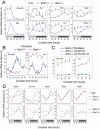Redundant function of REV-ERBalpha and beta and non-essential role for Bmal1 cycling in transcriptional regulation of intracellular circadian rhythms
- PMID: 18454201
- PMCID: PMC2265523
- DOI: 10.1371/journal.pgen.1000023
Redundant function of REV-ERBalpha and beta and non-essential role for Bmal1 cycling in transcriptional regulation of intracellular circadian rhythms
Abstract
The mammalian circadian clockwork is composed of a core PER/CRY feedback loop and additional interlocking loops. In particular, the ROR/REV/Bmal1 loop, consisting of ROR activators and REV-ERB repressors that regulate Bmal1 expression, is thought to "stabilize" core clock function. However, due to functional redundancy and pleiotropic effects of gene deletions, the role of the ROR/REV/Bmal1 loop has not been accurately defined. In this study, we examined cell-autonomous circadian oscillations using combined gene knockout and RNA interference and demonstrated that REV-ERBalpha and beta are functionally redundant and are required for rhythmic Bmal1 expression. In contrast, the RORs contribute to Bmal1 amplitude but are dispensable for Bmal1 rhythm. We provide direct in vivo genetic evidence that the REV-ERBs also participate in combinatorial regulation of Cry1 and Rorc expression, leading to their phase-delay relative to Rev-erbalpha. Thus, the REV-ERBs play a more prominent role than the RORs in the basic clock mechanism. The cellular genetic approach permitted testing of the robustness of the intracellular core clock function. We showed that cells deficient in both REV-ERBalpha and beta function, or those expressing constitutive BMAL1, were still able to generate and maintain normal Per2 rhythmicity. Our findings thus underscore the resilience of the intracellular clock mechanism and provide important insights into the transcriptional topologies underlying the circadian clock. Since REV-ERB function and Bmal1 mRNA/protein cycling are not necessary for basic clock function, we propose that the major role of the ROR/REV/Bmal1 loop and its constituents is to control rhythmic transcription of clock output genes.
Conflict of interest statement
The authors have declared that no competing interests exist.
Figures





Similar articles
-
The orphan nuclear receptor REV-ERBalpha controls circadian transcription within the positive limb of the mammalian circadian oscillator.Cell. 2002 Jul 26;110(2):251-60. doi: 10.1016/s0092-8674(02)00825-5. Cell. 2002. PMID: 12150932
-
Differential control of Bmal1 circadian transcription by REV-ERB and ROR nuclear receptors.J Biol Rhythms. 2005 Oct;20(5):391-403. doi: 10.1177/0748730405277232. J Biol Rhythms. 2005. PMID: 16267379
-
REV-ERBα and REV-ERBβ function as key factors regulating Mammalian Circadian Output.Sci Rep. 2019 Jul 15;9(1):10171. doi: 10.1038/s41598-019-46656-0. Sci Rep. 2019. PMID: 31308426 Free PMC article.
-
Genetics and neurobiology of circadian clocks in mammals.Cold Spring Harb Symp Quant Biol. 2007;72:251-259. doi: 10.1101/sqb.2007.72.052. Cold Spring Harb Symp Quant Biol. 2007. PMID: 18419282 Free PMC article. Review.
-
Circadian stabilization loop: the regulatory hub and therapeutic target promoting circadian resilience and physiological health.F1000Res. 2022 Oct 31;11:1236. doi: 10.12688/f1000research.126364.2. eCollection 2022. F1000Res. 2022. PMID: 36415204 Free PMC article. Review.
Cited by
-
New insights into non-transcriptional regulation of mammalian core clock proteins.J Cell Sci. 2020 Sep 15;133(18):jcs241174. doi: 10.1242/jcs.241174. J Cell Sci. 2020. PMID: 32934011 Free PMC article. Review.
-
Picrotoxin dramatically speeds the mammalian circadian clock independent of Cys-loop receptors.J Neurophysiol. 2013 Jul;110(1):103-8. doi: 10.1152/jn.00220.2013. Epub 2013 Apr 10. J Neurophysiol. 2013. PMID: 23576702 Free PMC article.
-
PER2 Circadian Oscillation Sensitizes Esophageal Cancer Cells to Chemotherapy.Biology (Basel). 2021 Mar 26;10(4):266. doi: 10.3390/biology10040266. Biology (Basel). 2021. PMID: 33810377 Free PMC article.
-
Tuning the mammalian circadian clock: robust synergy of two loops.PLoS Comput Biol. 2011 Dec;7(12):e1002309. doi: 10.1371/journal.pcbi.1002309. Epub 2011 Dec 15. PLoS Comput Biol. 2011. PMID: 22194677 Free PMC article.
-
Cell state dependent effects of Bmal1 on melanoma immunity and tumorigenicity.Nat Commun. 2024 Jan 20;15(1):633. doi: 10.1038/s41467-024-44778-2. Nat Commun. 2024. PMID: 38245503 Free PMC article.
References
-
- Young MW, Kay SA. Time zones: A comparative genetics of circadian clocks. Nat Rev Genet. 2001;2:702–715. - PubMed
-
- Liu AC, Lewis WG, Kay SA. Mammalian circadian signaling networks and therapeutic targets. Nat Chem Biol. 2007;3:631–639. - PubMed
-
- Reppert SM, Weaver DR. Coordination of circadian timing in mammals. Nature. 2002;418:935–941. - PubMed
-
- Giguere V. Orphan nuclear receptors: From gene to function. Endocrine Rev. 1999;20:689–725. - PubMed
-
- Preitner N, Damiola F, Molina LL, Zakany J, Duboule D, et al. The orphan nuclear receptor REV-ERB alpha controls circadian transcription within the positive limb of the mammalian circadian oscillator. Cell. 2002;110:251–260. - PubMed
Publication types
MeSH terms
Substances
Grants and funding
LinkOut - more resources
Full Text Sources
Molecular Biology Databases

